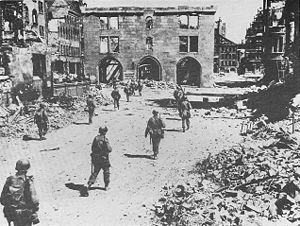You can help expand this article with text translated from the corresponding article in German. (October 2020) Click [show] for important translation instructions.
|
| Battle of Nuremberg | |||||||
|---|---|---|---|---|---|---|---|
| Part of the Western Allied invasion of Germany in the Western Front | |||||||
 American soldiers of the 3rd Infantry Division walk through a devastated Nuremberg. | |||||||
| |||||||
| Belligerents | |||||||
|
|
| ||||||
| Commanders and leaders | |||||||
|
|
| ||||||
| Units involved | |||||||
|
Remnants and militia from: | |||||||
| Strength | |||||||
| 45,000 troops[2] |
2 divisions (est. 20,000–50,000) 2 regiments (est. 2,000–11,000) ROA troops (est. 18,000) Several ad hoc units of Luftwaffe (est. 2,000)[2] and Volkssturm[3] | ||||||
The Battle of Nuremberg was a five-day battle between the forces of the United States 7th Army on one side, and Nazi Germany on the other during the last days of World War II. The battle saw some of the fiercest urban combat during the war and it took four days for the United States to capture the city. The battle was a blow to Nazi Germany as Nuremberg was a center of the Nazi regime. The Nuremberg Rallies took place in the city and to lose the city to the Americans took a heavy toll on already low German morale.[1] Even though American forces heavily outnumbered the German forces,[2] it wasn't until 20 April, that the 7th Army took the city center. The battle devastated the city.
- ^ a b "End of the War in Nuremberg - Nuremberg - Battle for a Symbol". kriegsende.nuernberg.de. Archived from the original on 20 May 2007. Retrieved 14 April 2012.
- ^ a b c "End of the War in Nuremberg - Unequal Forces Line Up for Battle". kriegsende.nuernberg.de. Archived from the original on 6 January 2013. Retrieved 14 April 2012.
- ^ MacDonald, Charles B. (1993). The Last Offensive. Washington D.C.: GPO. p. 423.